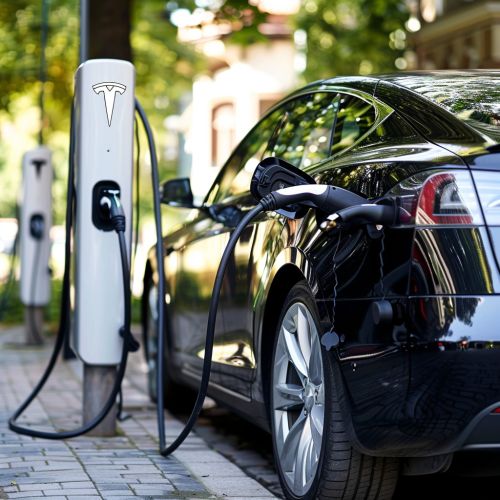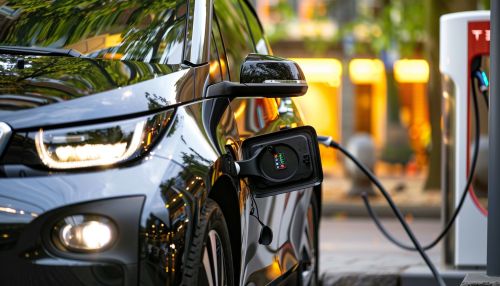Electric car
Introduction
An electric car is a type of automobile that is propelled by one or more electric motors, using energy stored in rechargeable batteries. Unlike internal combustion engine vehicles, electric cars do not rely on fossil fuels and produce zero tailpipe emissions, making them a cleaner alternative for transportation. The development and adoption of electric cars have been driven by concerns over environmental pollution, the depletion of fossil fuel resources, and advancements in battery technology.
History
The concept of electric vehicles (EVs) dates back to the early 19th century. The first crude electric carriage was built by Robert Anderson in Scotland around 1832. However, it wasn't until the late 19th and early 20th centuries that electric cars became more practical and popular. By the early 1900s, electric cars accounted for a significant portion of the automobile market, especially in urban areas where their quiet operation and ease of use were highly valued.
The advent of the internal combustion engine and the mass production techniques pioneered by Henry Ford led to a decline in the popularity of electric cars. Gasoline-powered vehicles offered longer range, faster speeds, and lower costs, which overshadowed the benefits of electric cars. It wasn't until the late 20th century, with growing environmental awareness and technological advancements, that electric cars began to regain attention.
Technology
Electric Motors
Electric cars use electric motors to convert electrical energy into mechanical energy. The most common types of electric motors used in electric cars are:
- **Induction Motors**: These motors, also known as asynchronous motors, are widely used due to their robustness and efficiency. They operate on the principle of electromagnetic induction and do not require brushes or commutators, which reduces maintenance.
- **Permanent Magnet Motors**: These motors use permanent magnets to create a magnetic field, which interacts with the electric current in the motor windings to produce motion. They are known for their high efficiency and compact size.
- **Brushless DC Motors**: These motors combine the characteristics of both induction and permanent magnet motors. They are highly efficient and have a long lifespan due to the absence of brushes.
Batteries
The performance and range of electric cars are heavily dependent on the type and capacity of their batteries. The most common types of batteries used in electric cars are:
- **Lithium-ion Batteries**: These batteries are the most widely used in modern electric cars due to their high energy density, long cycle life, and relatively low weight. They consist of a lithium-based cathode, a graphite anode, and an electrolyte that facilitates the movement of lithium ions.
- **Nickel-Metal Hydride (NiMH) Batteries**: These batteries were commonly used in earlier electric and hybrid vehicles. They offer good energy density and are less prone to thermal runaway compared to lithium-ion batteries. However, they are heavier and have a shorter lifespan.
- **Solid-State Batteries**: An emerging technology, solid-state batteries use a solid electrolyte instead of a liquid one. They promise higher energy density, improved safety, and longer lifespan. However, they are still in the development stage and not yet widely available.
Charging Infrastructure
The widespread adoption of electric cars is closely linked to the availability of charging infrastructure. There are several types of charging stations:
- **Level 1 Charging**: This is the most basic form of charging, using a standard household outlet (120V). It provides a slow charging rate, typically adding about 2-5 miles of range per hour.
- **Level 2 Charging**: This type of charging uses a 240V outlet, similar to those used for household appliances like dryers. It offers a faster charging rate, adding about 10-60 miles of range per hour.
- **DC Fast Charging**: Also known as Level 3 charging, this method uses direct current (DC) to charge the battery at a much faster rate. It can add 60-100 miles of range in just 20-30 minutes. However, it requires specialized equipment and is typically found at public charging stations.


Environmental Impact
Electric cars are often touted for their environmental benefits, primarily due to their zero tailpipe emissions. However, their overall environmental impact depends on several factors:
Emissions
While electric cars produce no tailpipe emissions, the production of electricity used to charge them can generate emissions, depending on the energy source. Renewable energy sources such as wind, solar, and hydroelectric power produce minimal emissions, whereas fossil fuel-based power plants can generate significant amounts of greenhouse gases.
Battery Production and Recycling
The production of batteries for electric cars involves the extraction and processing of raw materials such as lithium, cobalt, and nickel. These processes can have environmental and social impacts, including habitat destruction, water pollution, and labor exploitation. Additionally, the recycling and disposal of batteries pose challenges due to the hazardous materials they contain.
Lifecycle Analysis
A comprehensive assessment of the environmental impact of electric cars requires a lifecycle analysis, which considers the emissions and resource use associated with the production, operation, and disposal of the vehicle. Studies have shown that, over their entire lifecycle, electric cars generally have a lower environmental impact compared to internal combustion engine vehicles, especially when charged with renewable energy.
Economic Impact
The adoption of electric cars has significant economic implications, affecting various industries and stakeholders:
Automotive Industry
The shift towards electric vehicles is driving changes in the automotive industry, including:
- **Manufacturing**: Electric cars have fewer moving parts compared to internal combustion engine vehicles, which simplifies manufacturing processes and reduces maintenance costs. However, it also requires new skills and technologies, leading to changes in the workforce and supply chain.
- **Research and Development**: Automakers are investing heavily in research and development to improve battery technology, increase vehicle range, and reduce costs. This has led to innovations in materials science, electronics, and software.
- **Market Dynamics**: The growing demand for electric cars is reshaping the competitive landscape of the automotive market. Traditional automakers are facing competition from new entrants, including technology companies and startups focused on electric mobility.
Energy Sector
The widespread adoption of electric cars has implications for the energy sector, including:
- **Electricity Demand**: The increased use of electric cars is expected to drive up electricity demand, requiring investments in grid infrastructure and renewable energy sources to meet this demand sustainably.
- **Energy Storage**: Electric car batteries can serve as a form of distributed energy storage, helping to balance supply and demand on the grid. Vehicle-to-grid (V2G) technology allows electric cars to feed electricity back into the grid during peak demand periods.
- **Oil Industry**: The transition to electric vehicles is expected to reduce demand for oil, impacting the oil industry and related sectors. This shift could lead to changes in global energy markets and geopolitics.
Challenges and Future Prospects
Despite the benefits of electric cars, several challenges remain:
Range Anxiety
One of the main concerns for potential electric car buyers is range anxiety, the fear that the vehicle will run out of charge before reaching the destination. Advances in battery technology and the expansion of charging infrastructure are helping to alleviate this concern.
Charging Infrastructure
The availability and accessibility of charging stations are critical for the widespread adoption of electric cars. While urban areas are seeing rapid growth in charging infrastructure, rural and remote areas still face challenges.
Battery Technology
Improving battery technology is essential for increasing the range, reducing the cost, and enhancing the safety of electric cars. Research is ongoing in areas such as solid-state batteries, fast-charging technologies, and alternative materials.
Cost
The upfront cost of electric cars is generally higher than that of internal combustion engine vehicles, primarily due to the cost of batteries. However, lower operating and maintenance costs, along with government incentives, can make electric cars more cost-effective over their lifetime.
Policy and Regulation
Government policies and regulations play a crucial role in promoting the adoption of electric cars. Incentives such as tax credits, rebates, and subsidies can help reduce the cost barrier, while regulations on emissions and fuel efficiency can drive automakers to invest in electric vehicle technology.
